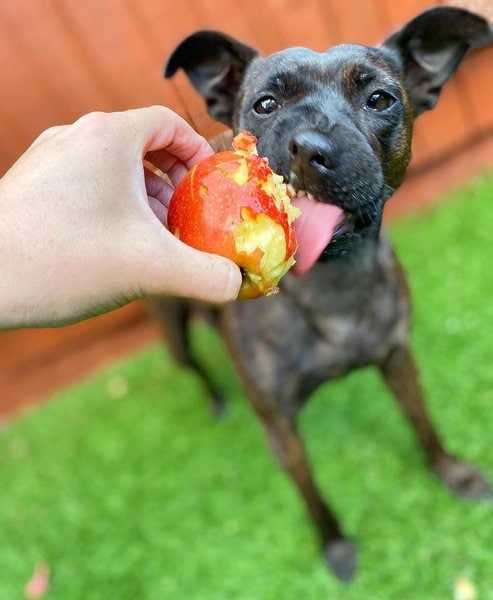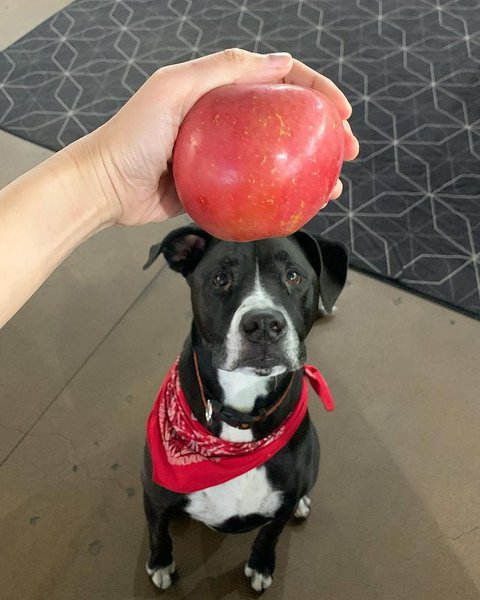As the adage goes, an apple a day keeps the doctor away. And whether you admit it or not, we must have, at one point or another, wondered whether this benefit extends to our canine buddies as well.
So, can dogs eat apple skin and peels? Yes, dogs can eat apple skin and peels in moderate amounts. And the low-calorie content of the apple fruit, as well as the amount of nutrients and minerals contained in this fruit, makes it a worthwhile and healthy treat to feed your dog with.
As wonderful as the apple fruit can be for dogs, there are portions of this fruit that should be kept away from dogs, and along with the several health benefits that your pooch can derive from eating this fruit, they are all covered in this article. However, before we go further, let’s provide a concrete answer as to why dogs can eat apples and the various ways of feeding this tasty fruit to your canine buddy.
Can Dogs Eat Apple Skin And Peels?

Yes, dogs can eat moderate quantities of apple skin and peels, but portions of the fruit such as the tough core and the stem should be avoided at all costs.
The apple is arguably one of, if not the most popular fruit in the world, and it also makes the exclusive list of fruits that are safe for consumption by dogs, in moderation, of course!
Apples are safe for dogs to eat because, if served properly, they typically contain no substances that are toxic for dogs, and they also come with a host of nutritional positives that a pooch can benefit from.
The choice of apples that a dog can eat isn’t limited by color or type. And red apples, as well as Honeycrisp apples, gala apples, and all other varieties of an apple that can be found at your local grocery store, are safe for pooches to feast on.How Can I Prepare Apple Skin For My Dog To Eat?
Before preparing apples for your dog to eat, it is essential that you take time to thoroughly wash and scrub the body of the fruit to get rid of dirt and harmful bacteria. Some apples, especially those gotten from the supermarket, typically contain pesticides, and if not thoroughly washed off, can be extremely toxic to a dog when ingested.
Once the apple has been washed, the next step is to cut the fruit into small, bite-sized pieces that your dog can easily chew and swallow. Also, while slicing the apple, make sure to get rid of the seeds, as these contain little amounts of cyanide that can be toxic to dogs. The apple core and the stem also pose choking risks, and these should be eliminated as well.
It may seem like unnecessary work, but peeling the apple before feeding it to your dog can make digestion easier and also reduce the amount of fiber that your canine buddy will be taking in.
How Many Apples Can My Dog Eat?
Dogs enjoy crunching on apples and will continue eating as long as this fruit is made available – the tasty nature of the apple makes this understandable. However, as a dog parent, it is your duty to exercise restraint when feeding your Fido with this fruit, as too much of it can lead to your canine buddy developing health problems.
That said, it is recommended that you feed your pooch with one or two slices of apple per day. Anything more, and you risk placing your canine buddy in danger of suffering from an upset stomach.
Why Should Dogs Eat Apple Skin And Peels?

Apple skins and peels contain several nutrients and minerals which work together to ensure the well-being of a dog. The low-calorie content of apple skins and peels also makes them ideal for dogs looking to maintain a healthy weight.
Apple Skin And Peels Contain Several Beneficial Nutrients
The nutritional content of apple skins includes vitamins such as vitamin A and C, which are known to:
- possess immunity-boosting properties that can help a dog fight off diseases easily
- contribute to proper development and the maintenance of a pooch’s skin and coat
- promote good eyesight in dogs
Apple skins also contain a significant amount of potassium and antioxidants, both of which carry out important functions in aiding disease prevention, as well as in the maintenance of a dog’s internal pH levels.
Apple Peels Contain A Healthy Amount Of Fiber
Apple peels boast a large amount of fiber, which can be of immense benefit to a pooch’s digestive system when ingested. Similarly, fiber contained in apple peels is often converted into fatty acids within a pooch’s body, which in turn helps prevent the growth of harmful bacteria in the dog’s intestines.
Apple Peels Help With Weight Maintenance
Additionally, apple peels contain ursolic acid, which is known to be essential for the maintenance of a healthy weight in a dog. And it is this property that makes apple peels a great choice for dogs suffering from weight-related issues such as obesity.
Chewing Apple Skin Can Be Great For Dental Health
The crunchy nature of an apple and the grinding effect it typically has on a dog’s teeth when being chewed makes it effective at getting rid of plaque build-up on a dog’s teeth in some cases.
However, just as chewing apples can help get rid of plaque and tartar build-up in a dog’s mouth, pieces of apple can get stuck and decay between the Fido’s teeth, thereby resulting in the pooch developing an offensive mouth odor. Consequently, chewing apple skins shouldn’t be used as a substitute for regular and proper canine dental care.
Can Apples Be Bad For Dogs?
When consumed in large amounts, fiber contained in apple skin and peels can result in an upset stomach for the dog. Additionally, apple seeds contain cyanide, and this can be toxic to a dog when ingested in large quantities.
Digestive Upset
We’ve stated earlier how apple skin is safe for dogs to eat in moderate amounts. But feeding large quantities of this fruit to your furry friend can result in a digestive upset which will make your Fido feel very uncomfortable.
Ideally, this risk should be minimized, and it is achieved by gradually introducing this fruit to your canine buddy while closely monitoring the pooch for signs of a gastrointestinal disturbance.

Cyanide Poisoning
We’ve established that moderate amounts of apple skin and peels are safe for dogs to eat, but one part of the apple that shouldn’t be fed to a pooch is the seed.
Like most other seeds, the apple seed contains traces of cyanide, and consumption of a significantly large amount of apple seeds can result in cyanide poisoning in a dog. Signs exhibited by a dog suffering from cyanide toxicity include excessive salivation, breathing difficulties, paralysis, and convulsions.
Cyanide poisoning in dogs is a medical emergency, and immediately you observe any of the aforementioned symptoms after your pooch must have chewed and swallowed apple seeds, you should immediately get in touch with your vet!
On a positive note, studies have shown that a dog would have to consume hundreds of apple seeds to suffer symptoms associated with cyanide poisoning; Hence, you can rest easy if your Fido has consumed just a few apple seeds while taking steps to ensure that this doesn’t reoccur in the future.
Risk Of Choking
The tough apple core and fruit stem aren’t easily digestible materials, and when ingested, can get lodged between the dog’s throat, causing the pooch to choke and subsequently suffer from a gastrointestinal obstruction.





